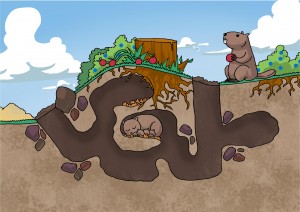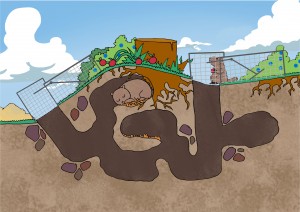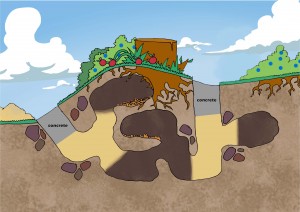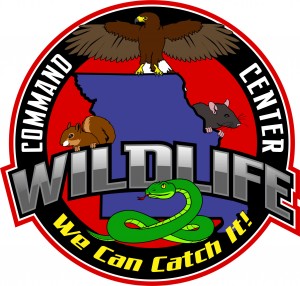How to get rid of a Groundhog or Woodchuck in St Louis, Missouri
Michael E Beran
314-399-8272
beran.michael@gmail.com
Text Msg to 314-502-8339
St Louis Groundhog Control
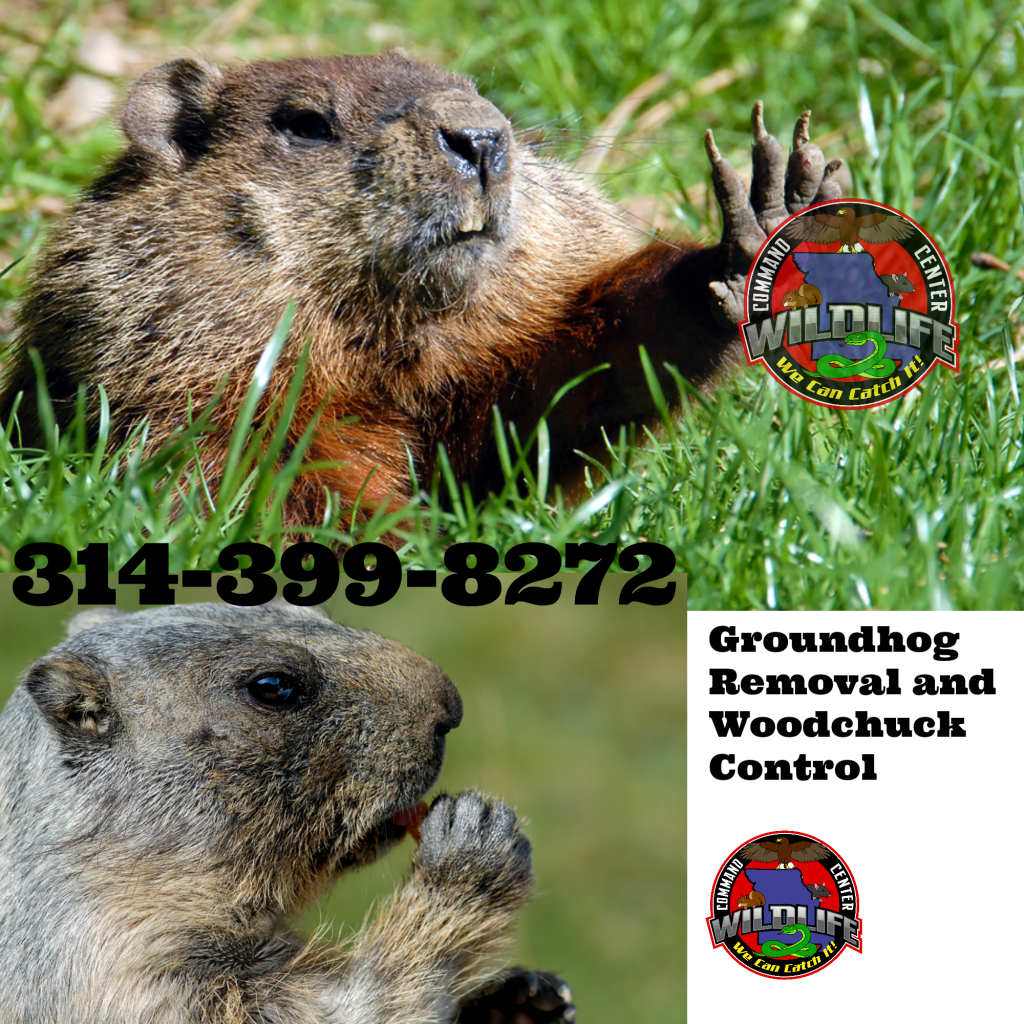
Groundhog Woodchuck removal control how to get rid of Whistle Pigs
Eliminate Attractants
Groundhogs will enter your yard to find food and a safe place to burrow. It’s important that you take some steps to minimize damage and make your yard less attractive. Woodchucks love to burrow under sheds, decks and raised flower beds, making these areas harder to use of difficult to dig can be effective in dissuading Woodchucks from using the area. Groundhogs prefer burrowing in areas that provide ample cover; remove piles of debris, rocks and/or wood where groundhogs may take shelter. Use gravel to fill in any abandoned animal burrows.
Harvest crops like beans, peas and melons as early as possible. Dark green leafy vegetables and such plants that grow in yards attract Woodchucks, keep broad leaf plants (weeds) under control in your yard at all times, it is one of the easiest ways to control woodchuck activities. Trim back plants groundhogs may eat or use for cover. Remove any tree trunks or other sources of wood that groundhogs can gnaw or grind their teeth on.
Identify Areas of Damage
Becoming familiar with your groundhog’s habits and where it spends most of its time will help you target a control method.
Common groundhog activities include:
1. damaging, eating and digging up crops like peas, beans, melons and alfalfa
2. eating grasses, dandelions and clover
3. gnawing/clawing and chewing wood or woody vegetation like trees and shrubs
4. chewing through electrical wires/tubing, irrigation lines and cable runs
5. digging holes and burrowing under lawn or structures
Seek out any groundhog burrows on your property – you can identify these by locating their entrances/exits. Burrows generally contain 3-5 entrance holes, each about 7-8 inches in diameter. Groundhogs often hide these holes by digging them underneath vegetation and/or loosely covering them up with leaves and sticks.
Choose a Control Method
Once you’ve identified the general whereabouts of your groundhog and what kind of damage it is causing, you can select the best control method. The more methods you use, the better your chances are at getting rid of groundhogs and keeping them off your property.
Live Groundhog Trap
The most effective way to remove a groundhog is with a live groundhog trap. Groundhogs are cautious creatures, so keep in mind the following tips:
Prevent transferring your scent to the trap by wearing gloves when handling it.
Bait your trap in a way that forces the groundhog to fully enter it – this will ensure the animal cannot back out when the door comes down.
Prevent roll over and escapes after the groundhog is caught by ensure the trap cannot move. Place a brick on the top for extra stability.
Camouflage the inside and outside of the trap with leaves so that the groundhog feels more comfortable entering.
For more tips and step-by-step instructions, read (How To Trap a Groundhog)
Woodchuck / Groundhog Trapping Tips:
You can use either a lethal body-grip trap mounted right over the hole, or a live capture cage trap. The lethal type of trap is guaranteed to work, but it’s very dangerous to use, and should only be set by professionals with experience. It can also kill unintentional animals, and is illegal in many states. A live cage trap has a lower success rate, but if you set it on the groundhog pathway and bait it with tasty vegetables, you’ll probably get the woodchuck, and then you can relocate it a few miles away.
What Bait To Use In Groundhog Traps
The joke of the trapping industry is to use apples coated with peanut butter. I have no idea why, but every do-it-yourself amateur homeowner seems to know to use apples with peanut butter as bait. Unfortunately, that bait isn’t very effective. Groundhogs are herbivores, and in reality, fresh vegetables work best – such as broccoli, corn, beans, etc.
How to Catch a Groundhog
BEST GROUNDHOG REMOVAL COMPANY IN ST LOUIS MISSOURI
Groundhog Control & Removal
Need groundhog removal in your town? Call Wildlife Command Center now @ 314-399-8272
Groundhogs, also known as woodchucks, are large, ground-dwelling rodents. Adults average about ten pounds. They are strictly vegetarians, as many people know, based on the damage in their garden. Groundhogs dig large, complex, interconnecting burrows. They are excellent & prolific diggers. Each spring, a female gives birth to 4-6 young. Groundhogs are true hibernators in the northern parts of their range. The spring emergence always occurs exactly on February 2nd. Oftentimes the groundhog will engage in a behavior known as shadow spotting. Well, perhaps that’s not true, but they do emerge in he springtime and resume their digging patterns.
Expert Tips
If not properly controlled, groundhogs can cause serious structural damage when burrowing. Their tunnels break apart building foundations, and they will often chew through electrical wires and irrigation systems that may be in their way. For best results, use multiple groundhog control products at once.
Groundhogs enter into deep hibernation in the winter, at which time they are underground and inactive. Because of this, groundhog control efforts will only be effective in warmer months.
The best time to try to get rid of groundhogs is early in the spring, before mating season. Once a groundhog enters gestation, it will be difficult to repel them. And once a groundhog gives birth, you’ll have more groundhogs on your property to control.
Plantings, woodpiles and debris surrounding your home provide shelter for groundhogs, making them more likely to live on your property or burrow underneath the grass or foundation. Minimizing ground cover will prevent this type of destructive behavior.
Before operating a live trap, get to know your local laws regarding trapping and relocating groundhogs or woodchucks.
Prevent groundhogs from occupying abandoned burrows by covering openings with wired fencing. VERY IMPORTANT: make sure that there are no groundhogs living in the burrow. Identify all openings (there should be 2-5). Dig each out about 1 foot deep, then cover the hole with 3′ x 3′ of wire fencing and bury the fencing securely. Ignoring the signs communicated by woodchucks, AKA the “groundhogs” (also spelled “ground hogs”), regarding their presence and intentions can spell disaster for your garden. As surely as Phil Connors had no future in “Groundhog Day,” doomed by his unawareness to relive the same day over and over, so your garden will have no future if you pay no heed to this garden pest’s sign language. Your garden will be trapped in a perpetual Groundhog Day of destruction, raided at will by the marauding rodents. No, you must learn to read the signs — and practice effective groundhog control.
This is the worst way to deal with Groundhogs but sometimes you have to learn what not to do as well as what works DO NOT USE THIS METHOD How to Kill a Groundhog with Poison
Many people turn to poison to get rid of their groundhog problems. There are several types of poisons on the market and they all work in various ways; with the end result death of the groundhog. Fumigation is a method under which gaseous pesticides or fumigants are used in the entire area to suffocate or poison the groundhogs within. The most widely used and preferred fumigant is Methyl Bromide. However, we need to understand that use of poison to get rid of groundhogs affects the human health as well. It is toxic to almost all forms of life and that includes human beings as well and should be used with extreme caution.
How to get rid of a Groundhog or Woodchuck in St Louis, Missouri
Michael E Beran
314-399-8272
beran.michael@gmail.com
Text Msg to 314-502-8339
St Louis Groundhog Control

